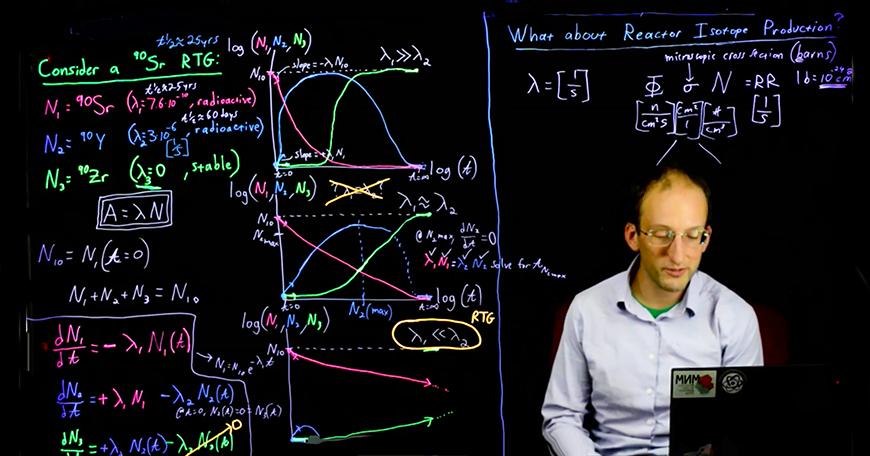Pedagogical innovations on or off campus

Prof Michael Short’s teaching philosophy has been the same whether teaching face-to-face or remotely:
He values personal connections, experiential learning, introducing context before theory (in accordance with Adult Learning Theory), and using compelling stories to bring course material to life. He is also committed to being consistently available and creating opportunities for one-on-one interactions with every student.
Highlights of the innovations Short has brought to his course 22.01-Intro to Ionizing Radiation and Nuclear Physics include:
Synchronous Lightboard
Prof Short built a lightboard studio similar to what ODL uses for MITx courses. But instead of making video recordings, he used it to teach synchronously. Students reported an enormous boost to engagement, as the lightboard not only recreated but surpassed the capabilities of black/white-boards.
Remote labs/kits/materials
Every student in Prof Short’s class received a kit with extensive electronics and tools (and safety equipment!) needed to build, test, and keep their own radiation Geiger counter. Short provided equipment the students could use in their individual environments. A radiation detector tube enabled students to build a Geiger counter and search for radiation near their homes using what they’d learned in class about naturally occurring radiation.
Prof Short also requested students to send him materials which were analyzed in his lab and used in experiments. For example, Short asked for students’ toenail clippings, had them neutronically activated in the MIT reactor, counted the gamma rays coming from them due to neutron activation, and sent his students their own raw data to analyze as a problem set (after clearance from COUHES, of course). Thus, students were themselves providing radiation data. In addition to toenails, students sent items for Short to isotopically identify and analyze during weekly lab sessions. Items ranged from a stone gathered on a hike, to a (fortunately real) diamond engagement ring.
Homework goals are clear; group work is strongly encouraged
Psets were designed with clearly articulated learning objectives such as mastering numerical integration, harvesting data from papers, understanding statistics and uncertainty, finding primary sources of data, and refuting fraudulent pseudoscience claims on the internet.
Prof Short encouraged and assigned group work for every pset. To motivate willingness to work in groups, Short shared data from an NSE survey of alums and employers that indicated group work was one of the two MIT grads’ weakest skills. Short switched groups every month, challenging students to welcome new partners, to see the benefits of diversity, and to develop skills to listen to and work with different people. To further promote and encourage group work, Short intentionally gave problems too hard for one student to accomplish in the allotted time alone, but easily doable by a group of three.
Ethics and Responsibility Prof Short spoke regularly to his students about their rights and expectations. He built a tool called "Do Less, Better," for which his 22.01 class functioned as a 25-student pilot. “Do Less, Better” helped students study more efficiently, tracking how many hours they spent weekly on their work in his and other classes. The success of the initiative may result in “Do Less, Better” being distributed Institute-wide.
Short encouraged students to speak out about courses at MIT where too much was required, and to speak up for themselves when unempathetic faculty ignored concerns about time management. Short’s pedagogical philosophy ensured that students successfully completed their weekly coursework but also maintained a balanced, well-rounded life.
Having successfully countered claims that the remote college experience is inferior in terms of teaching, Short excelled in giving his students a rich, full, MIT-caliber remote teaching experience. Thus the pandemic has provided yet another silver lining, spurning Short and others to think about how to optimize the educational experience and learning community despite some of the largest challenges presented to effective teaching.

